A few weeks ago I was able to photograph this Northern Harrier along the Antelope Island causeway. I like both of these shots because of the good look at the topside of the bird.

1/2000. f/6.3. ISO 500, 500 f/4, 1.4 tc, natural light, not set up, baited or called in
The background certainly isn’t “classic” by any means but it’s one found in very few places on the planet, which makes me appreciate it. The lighter colors are Great Salt Lake beach sand and the strips of red are windrows of brine fly pupae cases that have been washed up by the waves into parallel rows. And hey, their colors even go well with the bird (I know, I’m reaching for that one…)

1/2000. f/6.3. ISO 500, 500 f/4, 1.4 tc, natural light, not set up, baited or called in
This was the next shot in the burst. I prefer the second image because of the slightly better head turn toward the viewer, the more appealing catch light in the eye and the aerodynamic wing position that suggests speed. But I’m glad to have them both because decent flight shots of harriers don’t come easy.
Ron


Beautiful shots of one of my favorite birds. The white base of the tail and the facial disk are well displayed. Thank you!
Great captures, Ron! I almost didn’t publish the photo from last week’s refuge trip since the Harrier surprised me from behind (imagine that!). I fired off a couple of reflex shots but it was still a beautiful moment.
Ron:
I will echo Bob Zeller’s reply.
You wrote: “But I’m glad to have them both because decent flight shots of harriers don’t come easy.”
My version: “Decent flight shots of harriers don’t come.”
Dave
They’re a tough species, Dave. But you’ll get yours, I’m sure you will.
I like the way the pointed wings in the second shot illustrate why Harriers, aka “the Great Foolers”, are often mistaken for Falcons in flight. Wonderful pics and interesting tidbit about the brine fly casings too.
Mike, as a photographer I sometimes curse the white rump patch of the harrier because it’s so easy to overexpose but but it sure is handy for ID purposes. I hadn’t heard them referred to as “the Great Foolers”, but I can see why they’d be called that.
I really know that they don’t come easy. I am still working on my first.
You’ll get yours one day, Bob. Just like I’ll get my Sharp-shinned.
Great Shots Ron. They are always on the move, it’s difficult to photograph them most of the time.
That’s been my experience with them too, Mavourneen.
I like Marsh Hawks. They are one of the few birds that aren’t afraid to tangle with a large falcon. That makes them a pain to hunt near, but they are fascinating birds. Their flight is so light an bouyant.
The Mark Hawk is one of the few raptors that are sexually dimorphic with regards to color. This is an adult female. It would be interesting to compare this with similar shots of the blue/grey males.
I know you pride yourself on the fact that your shots are not set up, but Marsh Hawks are easy to call within camera range. They have a dish shaped face for the same reason that an owl does; they hunt almost exclusivly by sound. If you get a small sqeak call like those used for coyote calling (I have even used a dog’s sqeak toy) they will fly right up on top of you looking for the “mouse”.
Thanks for sharing your beautiful work.
Mark
Oops. That should be “Marsh Hawk” not “Mark Hawk”. Freudian slip?
Mark, I sometimes correct typos made in comments but this one was just too cute to fix
Hi Mark,
Just so everyone understands, I thought I’d mention that “Marsh Hawk” is a historical name for the Northern Harrier. Some also call them Hen Harriers. And yes, they’re absolutely fearless and don’t hesitate for a second to harrass buteos. Interesting that they’ll also tangle with the speedy and agile falcons.
My non-baiting isn’t so much a matter of pride as is it of field ethics. Baiting is a complex and controversial subject that I’ll likely cover in a future post.
For those who might like to see the dramatic sexual dimorphism in harriers that Mark refers to, here’s a couple of posts I’ve done on the male (gray ghost).
https://featheredphotography.com/blog/2011/10/27/strange-encounter-with-a-northern-harrier-and-a-junco/
https://featheredphotography.com/blog/2010/12/17/northern-harrier-males-grey-ghosts/
Beautiful shots. Love the colors. I like the first photo, you get to see the definition in the wing. Well done again Ron.
Thanks Bryce, Yes, the look at the wing definition is best in the first shot.